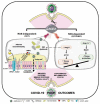Algae-Derived Bioactive Molecules for the Potential Treatment of SARS-CoV-2
- PMID: 33917694
- PMCID: PMC8068085
- DOI: 10.3390/molecules26082134
Algae-Derived Bioactive Molecules for the Potential Treatment of SARS-CoV-2
Abstract
The recently emerged COVID-19 disease caused by severe acute respiratory syndrome coronavirus 2 (SARS-CoV-2) has adversely affected the whole world. As a significant public health threat, it has spread worldwide. Scientists and global health experts are collaborating to find and execute speedy diagnostics, robust and highly effective vaccines, and therapeutic techniques to tackle COVID-19. The ocean is an immense source of biologically active molecules and/or compounds with antiviral-associated biopharmaceutical and immunostimulatory attributes. Some specific algae-derived molecules can be used to produce antibodies and vaccines to treat the COVID-19 disease. Algae have successfully synthesized several metabolites as natural defense compounds that enable them to survive under extreme environments. Several algae-derived bioactive molecules and/or compounds can be used against many diseases, including microbial and viral infections. Moreover, some algae species can also improve immunity and suppress human viral activity. Therefore, they may be recommended for use as a preventive remedy against COVID-19. Considering the above critiques and unique attributes, herein, we aimed to systematically assess algae-derived, biologically active molecules that could be used against this disease by looking at their natural sources, mechanisms of action, and prior pharmacological uses. This review also serves as a starting point for this research area to accelerate the establishment of anti-SARS-CoV-2 bioproducts.
Keywords: COVID-19 treatment; algae compounds; antiviral agent; bioactive entities; immunomodulatory; pharmacological uses; therapeutic aspects.
Conflict of interest statement
The authors declare no conflict of interest.
Figures




References
-
- Alam M.A., Xu J.L., Wang Z. Microalgae Biotechnology for Food, Health and High Value Products. Springer; Singapore: 2020. - DOI
-
- Zanella L., Alam M.A. Microalgae Biotechnology for Food, Health and High Value Products. Springer; Singapore: 2020. Extracts and Bioactives from Microalgae (Sensu Stricto): Opportunities and Challenges for a New Generation of Cosmetics; pp. 295–349.
-
- Galasso C., Gentile A., Orefice I., Ianora A., Bruno A., Noonan D.M., Sansone C., Albini A., Brunet C. Microalgal Derivatives as Potential Nutraceutical and Food Supplements for Human Health: A Focus on Cancer Prevention and Interception. Nutrients. 2019;11:1226. doi: 10.3390/nu11061226. - DOI - PMC - PubMed
-
- Pereira L., Critchley A.T. The COVID 19 novel coronavirus pandemic 2020: Seaweeds to the rescue? Why does substantial, supporting research about the antiviral properties of seaweed polysaccharides seem to go unrecognized by the pharmaceutical community in these desperate times? J. Appl. Phycol. 2020;32:1875–1877. doi: 10.1007/s10811-020-02143-y. - DOI - PMC - PubMed
Publication types
MeSH terms
Substances
LinkOut - more resources
Full Text Sources
Other Literature Sources
Research Materials
Miscellaneous

